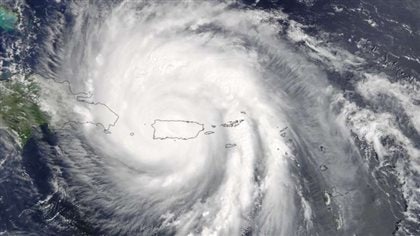Climate change, or the seeming effects of climate change, appeared to many of us on TV and digital screens around the world in September.
Following one of the worst wildfire seasons in British Columbia’s history, on the Pacific Coast of Canada, we were anticipating and then observing the harrowing images of the damage wrought by hurricanes of unprecedented size and frequency.
The island of Puerto Rico, in the Caribbean is still without power and pleading for emergency aid having been devastated by both hurricanes, Irma and Maria.
In southeastern Canada, people are just recovering from a powerful heatwave that had civic officials opening emergency shelters and reopening pools to help people cope, with advisories to check on the elderly and the very young, and to take shelter at midday.
“Global C02 emissions have not actually increased since 2013”
Professor Damon Matthews, Concordia University Research Chair, Climate Science and Sustainability, says when it comes to the reality of climate change, “some people are coming around, others are remaining intransigent on the issue of climate.”
ListenProfessor Matthews is the co-creator of the Climate Clock.
Along with musician and activist, David Usher, he created a chrono-metre with a countdown of time and and a count-up of CO2 emissions.

It is a very powerful tool with which to observe global conditions, and one doesn’t have to watch for long to become aware of deadlines.
The consequences, however, we are already beginning to experience.
Professor Matthews reminds people in the local Montreal region, that along with the record-breaking heat waves we have just emerged from in south eastern Canada, Montreal was the scene of violent devastation, with trees downed and cars smashed in the wake of several brief but powerful phenomenon known as microbursts.
He says, however, there is some good news.
The Climate Clock, which has been reset twice in the last two years, demonstrates this:
“Global C02 emissions have not actually increased since 2013, so we’ve had three years consecutive where C02 emissions have not gone up, and that’s actually a really big deal and it suggests that we may be actually at peak emissions and we may be at the point where C02 emissions could start to decrease in the years to come.” Matthews says.
The other thing that is really promising is how quickly solar and wind energy prices have decreased over the last several years, and the deployment and adoption of renewable energy technologies is moving forward at a rate that most people would not have predicted even a couple of years ago.”
The Climate Clock has been projected onto a large wall at Concordia, in downtown Montreal during the April 22nd Earth Day observances for the last two years.
While it is expensive to undertake these spectacles, Professor Matthews is hopeful another similar event might be arranged for the upcoming COP23 meeting in Bonn, Germany in early November.
The U.N. sponsored gathering will be the occasion where the latest global C02 emissions data will be released by the Global Carbon Project, Matthews says.
“Last year when we updated the numbers we actually saw that we’d added a year-and-a-half to the dates on the clock.” he said.
Professor Matthews is hoping the trend will continue and more time will be added in November as well.







For reasons beyond our control, and for an undetermined period of time, our comment section is now closed. However, our social networks remain open to your contributions.